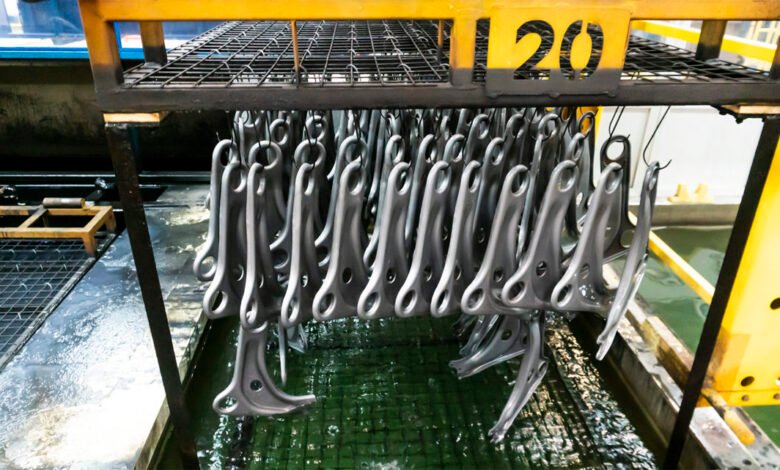The Complete Guide to Cataphoresis in 2024

Introduction
Cataphoresis might sound like a complex scientific term, but this electrochemical process is revolutionizing industries from automotive manufacturing to medical device production. Also known as electrophoretic deposition, cataphoresis uses electrical fields to move charged particles through a liquid medium, creating uniform coatings and finishes that traditional methods simply can’t match.
This comprehensive guide explores everything you need to know about cataphoresis—from the fundamental science behind the process to its cutting-edge applications across various industries. Whether you’re an engineer evaluating coating options or a business owner considering cataphoresis for your manufacturing process, you’ll discover why this technology is becoming the go-to solution for precision coating applications.
By the end of this post, you’ll understand how cataphoresis works, where it’s most effectively applied, and what future developments might mean for your industry.
Understanding the Science Behind Cataphoresis
Cataphoresis operates on the principle of electrophoresis, where charged particles migrate through a liquid medium under the influence of an electric field. When an electric current passes through a colloidal solution, positively charged particles move toward the negative electrode (cathode), while negatively charged particles travel toward the positive electrode (anode).
The process begins with preparing a stable colloidal suspension containing the material to be deposited. This suspension typically includes polymers, pigments, or other coating materials dispersed in a liquid carrier. The object requiring coating serves as one electrode, while a counter-electrode completes the electrical circuit.
Electric field strength determines the migration speed of particles, while solution pH and ionic strength affect particle stability and deposition quality. Temperature control ensures consistent viscosity and prevents unwanted chemical reactions during the coating process. These parameters must be carefully balanced to achieve optimal results.
The deposition occurs when particles reach the electrode surface and neutralize their charge, causing them to adhere to the substrate. This creates a uniform layer that can range from nanometers to several micrometers in thickness, depending on application requirements and process conditions.
Industrial Applications of Cataphoresis
Automotive Industry
The automotive sector represents the largest application area for cataphoresis technology. Major car manufacturers use electrophoretic deposition for primer coats on vehicle bodies, providing superior corrosion resistance and paint adhesion compared to conventional spray coating methods.
This process ensures complete coverage of complex geometries, including hard-to-reach areas like door frames, wheel wells, and structural joints. The uniform coating thickness prevents weak spots that could lead to rust formation over time. Additionally, cataphoresis eliminates the need for multiple coating passes, reducing production time and material waste.
Electronics Manufacturing
Electronic component manufacturers rely on cataphoresis for creating insulating layers on circuit boards and protective coatings on sensitive components. The process allows precise control over coating thickness at the microscopic level, essential for maintaining electrical properties and preventing short circuits.
Cataphoretic coatings also provide moisture protection for electronic assemblies, extending product lifespan in harsh environments. The ability to coat intricate component geometries makes this technology particularly valuable for miniaturized electronic devices.
Medical Device Production
Medical device manufacturers use cataphoresis to apply biocompatible coatings on implants, surgical instruments, and diagnostic equipment. These coatings can incorporate antimicrobial agents or provide specific surface properties required for biological compatibility.
The uniform coverage achieved through cataphoresis ensures consistent performance across the entire device surface, critical for medical applications where coating integrity directly impacts patient safety and treatment outcomes.
Aerospace Applications
Aerospace components require coatings that withstand extreme temperatures, pressure variations, and corrosive environments. Cataphoresis enables the application of specialized protective coatings on aircraft parts, satellite components, and rocket engine parts.
The process accommodates the complex shapes typical of aerospace components while maintaining the precise coating specifications required for flight safety and performance standards.
Key Benefits of Cataphoresis Technology
Superior Coating Uniformity
Traditional coating methods often struggle with complex geometries, leading to thickness variations that compromise performance. Cataphoresis delivers exceptional uniformity because the electric field ensures particles reach all surfaces equally, regardless of orientation or accessibility.
This uniformity extends to both visible surfaces and hidden areas, providing comprehensive protection that spray coating or dip coating cannot match. The result is consistent quality across entire production batches.
Environmental Advantages
Cataphoresis typically uses water-based solutions rather than organic solvents, significantly reducing volatile organic compound (VOC) emissions. This environmental benefit helps manufacturers comply with increasingly strict environmental regulations while reducing workplace health risks.
The process also minimizes material waste since overspray is virtually eliminated. Unused coating material can often be recirculated, further improving resource efficiency and reducing disposal costs.
Cost-Effective Production
While initial equipment investment can be substantial, cataphoresis offers long-term cost advantages through reduced material consumption, lower labor requirements, and decreased rework rates. Automated systems can operate continuously with minimal supervision, improving production efficiency.
The elimination of masking requirements for many applications reduces preparation time and material costs. Additionally, the superior coating quality reduces warranty claims and customer complaints associated with coating failures.
Enhanced Performance Characteristics
Cataphoretic coatings often exhibit superior adhesion, corrosion resistance, and durability compared to conventional alternatives. The electrochemical deposition process creates strong molecular bonds between the coating and substrate, resulting in excellent performance under challenging conditions.
These performance improvements translate into longer service life for coated products, reduced maintenance requirements, and improved customer satisfaction.
Future Trends in Cataphoresis Technology
Nanotechnology Integration
Researchers are developing cataphoretic processes that incorporate nanoparticles to create coatings with enhanced properties. These nanocomposite coatings can provide improved scratch resistance, self-cleaning surfaces, or specialized optical properties.
Carbon nanotubes and graphene particles are being investigated for creating electrically conductive coatings through cataphoresis, opening new applications in electronics and energy storage devices.
Smart Coating Development
Advanced cataphoretic coatings are being developed with responsive properties that change based on environmental conditions. These smart coatings might alter color, conductivity, or surface texture in response to temperature, pH, or mechanical stress.
Such innovations could revolutionize applications in sensors, adaptive surfaces, and self-healing materials, expanding cataphoresis beyond traditional protective coating roles.
Process Automation and Control
Industry 4.0 technologies are being integrated into cataphoresis systems, enabling real-time monitoring and adjustment of process parameters. Machine learning algorithms can predict optimal coating conditions based on substrate properties and desired outcomes.
These automated systems improve consistency, reduce operator training requirements, and enable rapid adaptation to new coating formulations or substrate materials.
Sustainable Material Development
Research continues into bio-based and recyclable materials for cataphoretic coatings, addressing growing sustainability concerns. These developments aim to maintain performance standards while reducing environmental impact throughout the product lifecycle.
Water-based formulations are being enhanced with renewable raw materials, and closed-loop recycling systems are being developed to further minimize waste generation.
Frequently Asked Questions
What types of materials can be coated using cataphoresis?
Cataphoresis can coat any electrically conductive substrate, including metals like steel, aluminum, and copper. Non-conductive materials can be treated with conductive primers or coatings to enable the cataphoretic process. The coating materials themselves can include polymers, ceramics, metals, and composite materials.
How thick can cataphoretic coatings be applied?
Coating thickness typically ranges from nanometers to approximately 50 micrometers, depending on the application and process parameters. Thicker coatings are possible but may require multiple deposition cycles or specialized formulations. Most industrial applications use coating thicknesses between 10 and 30 micrometers.
What are the main limitations of cataphoresis?
The primary limitations include the requirement for electrically conductive substrates, higher initial equipment costs compared to spray coating, and the need for skilled operators to manage process parameters. Complex substrate geometries may also require specialized electrode configurations to ensure uniform coating distribution.
How does cataphoresis compare to powder coating?
While both processes use electrical fields, cataphoresis occurs in liquid media and provides better coverage of complex shapes. Powder coating typically requires higher curing temperatures and may not reach recessed areas as effectively. Cataphoresis generally offers superior corrosion protection but may have higher operational complexity.
Can cataphoresis be used for decorative applications?
Yes, cataphoresis can produce decorative coatings with various colors, textures, and finishes. Metallic effects, color gradients, and specialized surface textures are achievable through careful formulation and process control. However, the process is most commonly used for functional protective coatings rather than purely decorative applications.
Embracing the Future of Advanced Coating Technology
Cataphoresis represents a sophisticated solution for modern coating challenges, offering unmatched uniformity, environmental benefits, and performance characteristics that traditional methods cannot achieve. As industries continue demanding higher quality standards and environmental responsibility, this technology provides a path forward that satisfies both requirements.
The ongoing development of smart coatings, nanotechnology integration, and sustainable materials promises to expand cataphoresis applications even further. Companies investing in this technology today position themselves advantageously for future manufacturing requirements and market demands.
Consider evaluating cataphoresis for your coating applications, particularly if you require superior uniformity, environmental compliance, or enhanced performance characteristics. Consult with coating specialists to determine how this advanced technology might benefit your specific manufacturing processes and product requirements.



